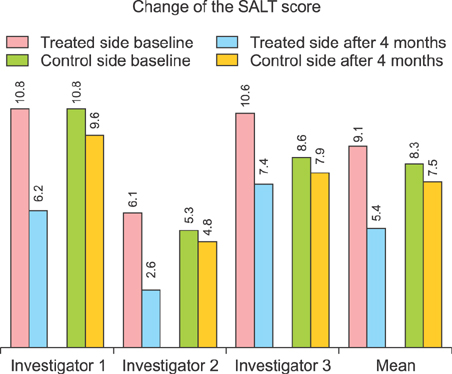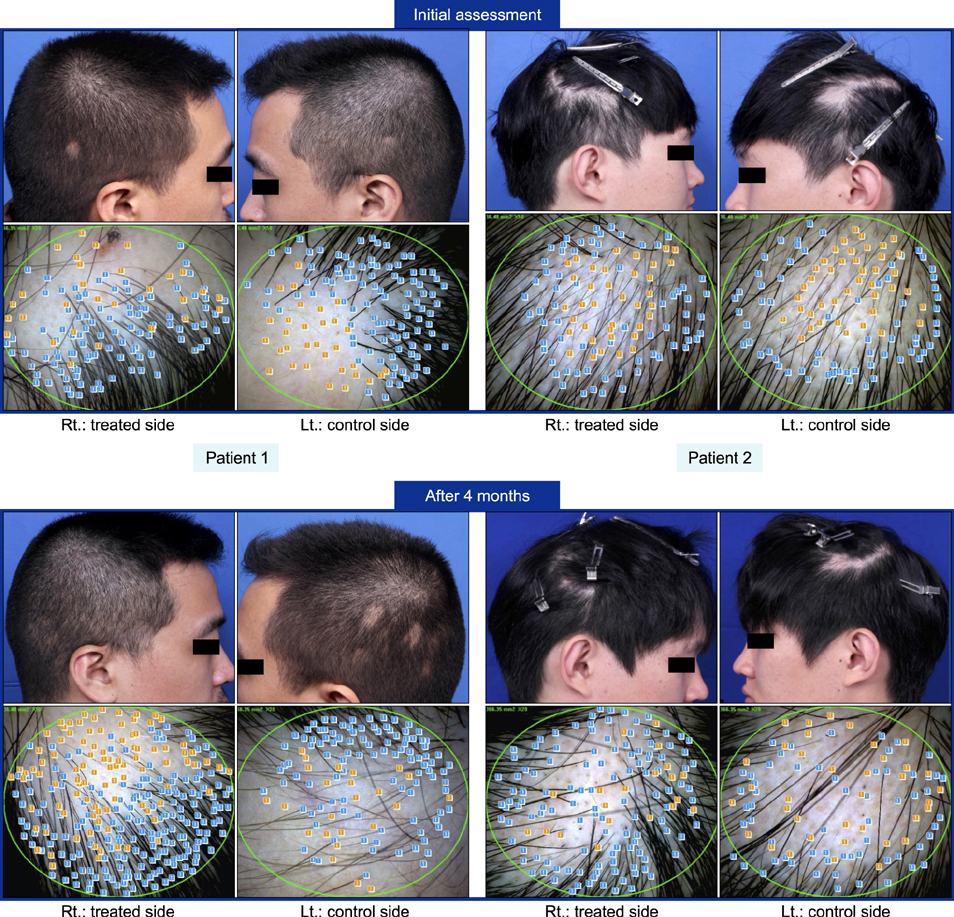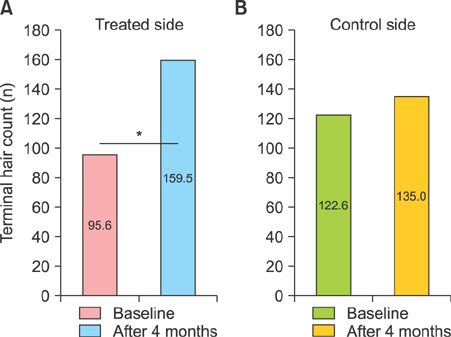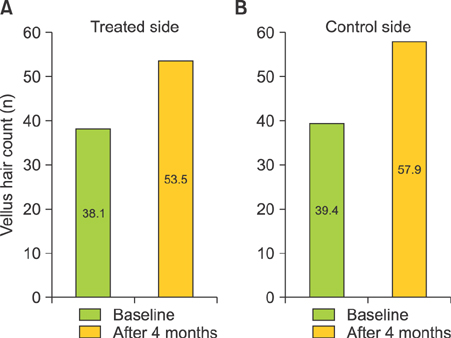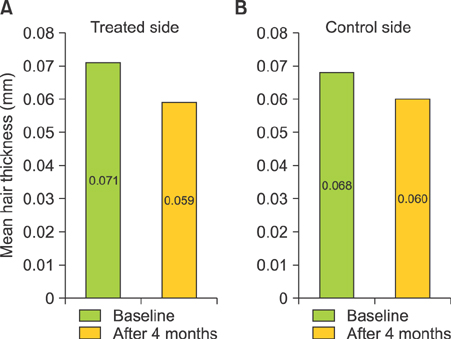Ann Dermatol.
2017 Dec;29(6):722-727. 10.5021/ad.2017.29.6.722.
Therapeutic Effect of Superficial Cryotherapy on Alopecia Areata: A Prospective, Split-scalp Study in Patients with Multiple Alopecia Patches
- Affiliations
-
- 1Department of Dermatology and Institute of Hair and Cosmetic Medicine, Yonsei University Wonju College of Medicine, Wonju, Korea. leewonsoo@yonsei.ac.kr
- KMID: 2395179
- DOI: http://doi.org/10.5021/ad.2017.29.6.722
Abstract
- BACKGROUND
Alopecia areata (AA) affects anagen hair follicles resulting in non-scarring hair loss. Since its introduction, superficial cryotherapy has been used as one of the meaningful treatment modalities for AA.
OBJECTIVE
The purpose of this study is to clarify the therapeutic efficacy and safety of superficial cryotherapy for treatment of AA.
METHODS
In 19 patients with multiple bilateral AA patches on their scalp, superficial cryotherapy was performed on the right side, every 2 weeks. Prednicarbate 0.25% solution was applied twice a day to both the treated and the control sides. Clinical improvement was estimated using the Severity of Alopecia Tool (SALT) score by 3 different dermatologists, along with the changes in terminal and vellus hair count and hair thickness analyzed by phototrichogram.
RESULTS
After 4 months of treatment, mean terminal hair count on the right scalp was 1.6-fold increased (p=0.005), while mean terminal hair count on the left scalp showed no significant change (110.1% increase, p=0.285). Mean SALT score decrease on the right was 4-fold greater than that on the left (40.7% and 9.6%), without statistical significance (p=0.282). Mean vellus hair count and mean hair thickness did not show significant changes after superficial cryotherapy. No remarkable adverse event was observed.
CONCLUSION
Superficial cryotherapy is an efficacious treatment modality with advantages of simplicity and noninvasiveness. It can be considered as a meaningful therapeutic modality for AA, especially when the disease status is limited to minimal to mild, or the conventional AA treatment is not applicable.
Figure
Reference
-
1. Gilhar A, Etzioni A, Paus R. Alopecia areata. N Engl J Med. 2012; 366:1515–1525.
Article2. Mirzoyev SA, Schrum AG, Davis MDP, Torgerson RR. Lifetime incidence risk of alopecia areata estimated at 2.1% by Rochester Epidemiology Project, 1990–2009. J Invest Dermatol. 2014; 134:1141–1142.
Article3. Alkhalifah A, Alsantali A, Wang E, McElwee KJ, Shapiro J. Alopecia areata update: part II. Treatment. J Am Acad Dermatol. 2010; 62:191–202. quiz 203–204.4. Messenger AG, McKillop J, Farrant P, McDonagh AJ, Sladden M. British Association of Dermatologists' guidelines for the management of alopecia areata 2012. Br J Dermatol. 2012; 166:916–926.
Article5. Downs AM, Lear JT, Kennedy CT. Anaphylaxis to intradermal triamcinolone acetonide. Arch Dermatol. 1998; 134:1163–1164.
Article6. Laing ME, Fallis B, Murphy GM. Anaphylactic reaction to intralesional corticosteroid injection. Contact Dermatitis. 2007; 57:132–133.
Article7. Huang P, Huang S, Wei G. One-hundred twenty three cases of alopecia areata treated with liquid nitrogen cryotherapy. J Clin Dermatol. 1986; 15:269.8. Lei Y, Nie Y, Zhang JM, Liao DY, Li HY, Man MQ. Effect of superficial hypothermic cryotherapy with liquid nitrogen on alopecia areata. Arch Dermatol. 1991; 127:1851–1852.
Article9. Kim TH, Kim DS, Kim SW. Effect of cryotherapy with liquid nitrogen on alopecia areata. Korean J Dermatol. 1994; 32:421–426.10. Lee BJ, Lee WS, Yoo MS, Ahn SK. Cryotherapy of alopecia areata. Korean J Dermatol. 1994; 32:416–420.11. Faghihi G, Radan M. Jet cryotherapy vs clobetasol proprionate lotion in alopecia areata. Skinmed. 2014; 12:209–211.12. Olsen EA, Hordinsky MK, Price VH, Roberts JL, Shapiro J, Canfield D, et al. Alopecia areata investigational assessment guidelines--Part II. National Alopecia Areata Foundation. J Am Acad Dermatol. 2004; 51:440–447.13. Olsen EA. Investigative guidelines for alopecia areata. Dermatol Ther. 2011; 24:311–319.
Article14. Hallgren KA. Computing inter-rater reliability for observational data: an overview and tutorial. Tutor Quant Methods Psychol. 2012; 8:23–34.
Article15. Morton CA, Birnie AJ, Eedy DJ. British Association of Dermatologists' guidelines for the management of squamous cell carcinoma in situ (Bowen's disease) 2014. Br J Dermatol. 2014; 170:245–260.
Article16. Radmanesh M, Azar-Beig M. Cryotherapy as an alternative therapy for the treatment of recalcitrant alopecia areata. Iran J Dermatol. 2013; 16:49–52.17. Hong SP, Jeon SY, Oh TH, Lee WS. A retrospective study of the effect of superficial cryotherapy on alopecia areata. Korean J Dermatol. 2006; 44:274–280.18. Lee SJ, Kim JY, Hann SK. Two cases of alopecia areata on eyebrow treated by superficial cryotherapy. Korean J Dermatol. 2003; 41:1079–1081.19. Jeon SY, Ahn BK, Lee S, Lee WS. Superficial cryotherapy of alopecia areata in eyebrows. Korean J Dermatol. 2004; 42:1024–1027.20. Muller SA, Winkelmann RK. Alopecia areata. An evaluation of 736 patients. Arch Dermatol. 1963; 88:290–297.21. MacDonald Hull SP, Wood ML, Hutchinson PE, Sladden M, Messenger AG. British Association of Dermatologists. Guidelines for the management of alopecia areata. Br J Dermatol. 2003; 149:692–699.
Article
- Full Text Links
- Actions
-
Cited
- CITED
-
- Close
- Share
- Similar articles
-
- Superficial Cryotherapy of Alopecia Areata in Eyebrows
- A Retrospective Study of the Effect of Superficial Cryotherapy on Alopecia Areata
- Two Cases of Alopecia Areata on Eyebrow Treated by Superficial Cryotherapy
- A Case of Acute Diffuse and Total Alopecia of the Female Scalp
- Congenital Triangular Alopecia

